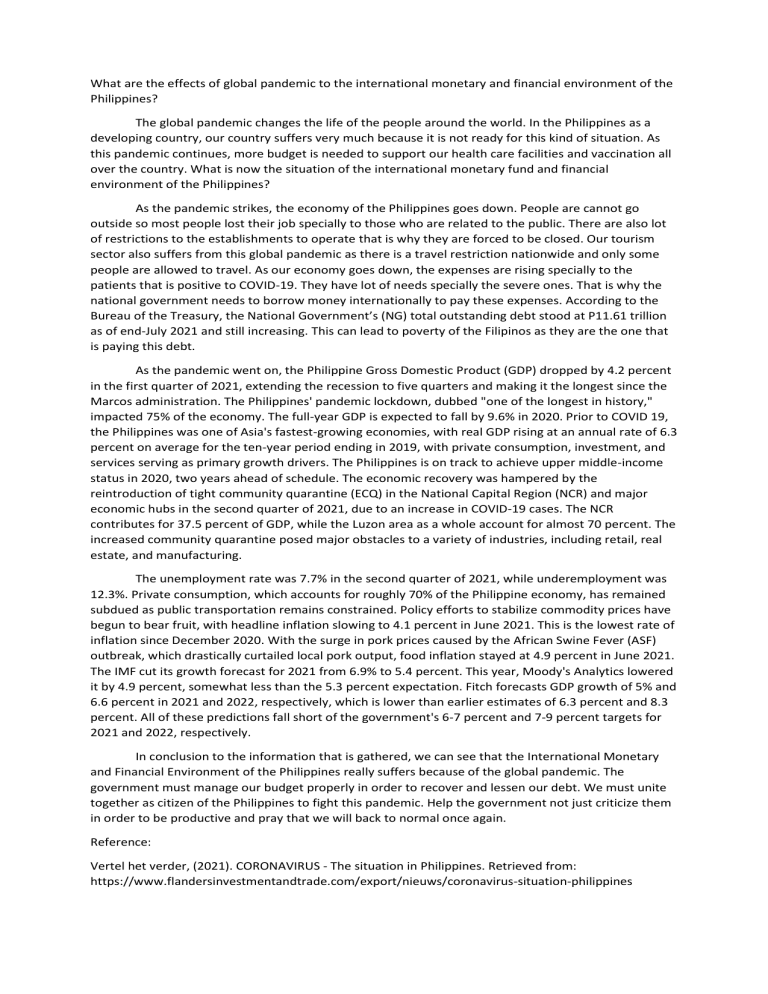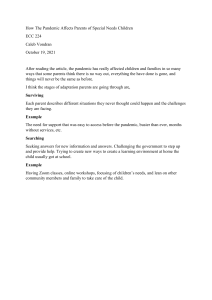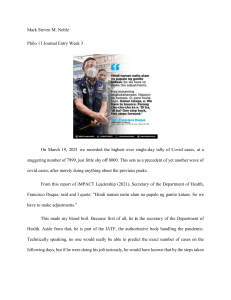
What are the effects of global pandemic to the international monetary and financial environment of the Philippines? The global pandemic changes the life of the people around the world. In the Philippines as a developing country, our country suffers very much because it is not ready for this kind of situation. As this pandemic continues, more budget is needed to support our health care facilities and vaccination all over the country. What is now the situation of the international monetary fund and financial environment of the Philippines? As the pandemic strikes, the economy of the Philippines goes down. People are cannot go outside so most people lost their job specially to those who are related to the public. There are also lot of restrictions to the establishments to operate that is why they are forced to be closed. Our tourism sector also suffers from this global pandemic as there is a travel restriction nationwide and only some people are allowed to travel. As our economy goes down, the expenses are rising specially to the patients that is positive to COVID-19. They have lot of needs specially the severe ones. That is why the national government needs to borrow money internationally to pay these expenses. According to the Bureau of the Treasury, the National Government’s (NG) total outstanding debt stood at P11.61 trillion as of end-July 2021 and still increasing. This can lead to poverty of the Filipinos as they are the one that is paying this debt. As the pandemic went on, the Philippine Gross Domestic Product (GDP) dropped by 4.2 percent in the first quarter of 2021, extending the recession to five quarters and making it the longest since the Marcos administration. The Philippines' pandemic lockdown, dubbed "one of the longest in history," impacted 75% of the economy. The full-year GDP is expected to fall by 9.6% in 2020. Prior to COVID 19, the Philippines was one of Asia's fastest-growing economies, with real GDP rising at an annual rate of 6.3 percent on average for the ten-year period ending in 2019, with private consumption, investment, and services serving as primary growth drivers. The Philippines is on track to achieve upper middle-income status in 2020, two years ahead of schedule. The economic recovery was hampered by the reintroduction of tight community quarantine (ECQ) in the National Capital Region (NCR) and major economic hubs in the second quarter of 2021, due to an increase in COVID-19 cases. The NCR contributes for 37.5 percent of GDP, while the Luzon area as a whole account for almost 70 percent. The increased community quarantine posed major obstacles to a variety of industries, including retail, real estate, and manufacturing. The unemployment rate was 7.7% in the second quarter of 2021, while underemployment was 12.3%. Private consumption, which accounts for roughly 70% of the Philippine economy, has remained subdued as public transportation remains constrained. Policy efforts to stabilize commodity prices have begun to bear fruit, with headline inflation slowing to 4.1 percent in June 2021. This is the lowest rate of inflation since December 2020. With the surge in pork prices caused by the African Swine Fever (ASF) outbreak, which drastically curtailed local pork output, food inflation stayed at 4.9 percent in June 2021. The IMF cut its growth forecast for 2021 from 6.9% to 5.4 percent. This year, Moody's Analytics lowered it by 4.9 percent, somewhat less than the 5.3 percent expectation. Fitch forecasts GDP growth of 5% and 6.6 percent in 2021 and 2022, respectively, which is lower than earlier estimates of 6.3 percent and 8.3 percent. All of these predictions fall short of the government's 6-7 percent and 7-9 percent targets for 2021 and 2022, respectively. In conclusion to the information that is gathered, we can see that the International Monetary and Financial Environment of the Philippines really suffers because of the global pandemic. The government must manage our budget properly in order to recover and lessen our debt. We must unite together as citizen of the Philippines to fight this pandemic. Help the government not just criticize them in order to be productive and pray that we will back to normal once again. Reference: Vertel het verder, (2021). CORONAVIRUS - The situation in Philippines. Retrieved from: https://www.flandersinvestmentandtrade.com/export/nieuws/coronavirus-situation-philippines





